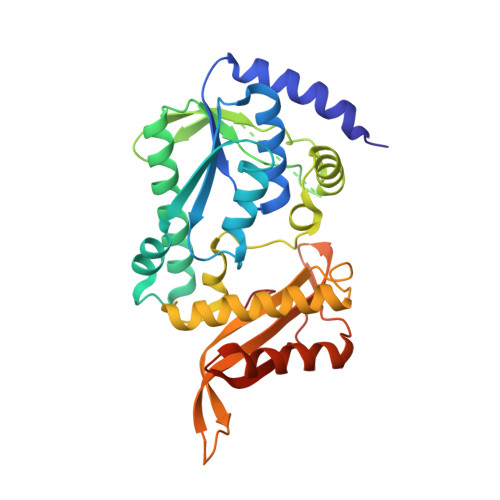Mechanistic Insights into the Functioning of a Two-Subunit GMP Synthetase, an Allosterically Regulated, Ammonia Channeling Enzyme.
Shivakumaraswamy, S., Kumar, S., Bellur, A., Polisetty, S.D., Balaram, H.(2022) Biochemistry 61: 1988-2006
- PubMed: 36040251
- DOI: https://doi.org/10.1021/acs.biochem.2c00151
- Primary Citation of Related Structures:
6JP9 - PubMed Abstract:
Guanosine 5'-monophosphate (GMP) synthetases, enzymes that catalyze the conversion of xanthosine 5'-monophosphate (XMP) to GMP, are composed of two different catalytic units, which are either two domains of a polypeptide chain or two subunits that associate to form a complex. The glutamine amidotransferase (GATase) unit hydrolyzes glutamine generating ammonia, and the ATP pyrophosphatase (ATPPase) unit catalyzes the formation of an AMP-XMP intermediate. The substrate-bound ATPPase allosterically activates GATase, and the ammonia thus generated is tunneled to the ATPPase active site where it reacts with AMP-XMP generating GMP. In ammonia channeling enzymes reported thus far, a tight complex of the two subunits is observed, while the interaction of the two subunits of Methanocaldococcus jannaschii GMP synthetase (MjGMPS) is transient with the underlying mechanism of allostery and substrate channeling largely unclear. Here, we present a mechanistic model encompassing the various steps in the catalytic cycle of MjGMPS based on biochemical experiments, crystal structure, and cross-linking mass spectrometry guided integrative modeling. pH dependence of enzyme kinetics establishes that ammonia is tunneled across the subunits with the lifetime of the complex being ≤0.5 s. The crystal structure of the XMP-bound ATPPase subunit reported herein highlights the role of conformationally dynamic loops in enabling catalysis. The structure of MjGMPS derived using restraints obtained from cross-linking mass spectrometry has enabled the visualization of subunit interactions that enable allostery under catalytic conditions. We integrate the results and propose a functional mechanism for MjGMPS detailing the various steps involved in catalysis.
- Molecular Biology and Genetics Unit, Jawaharlal Nehru Centre for Advanced Scientific Research, Jakkur, Bengaluru 560064, India.
Organizational Affiliation:



















